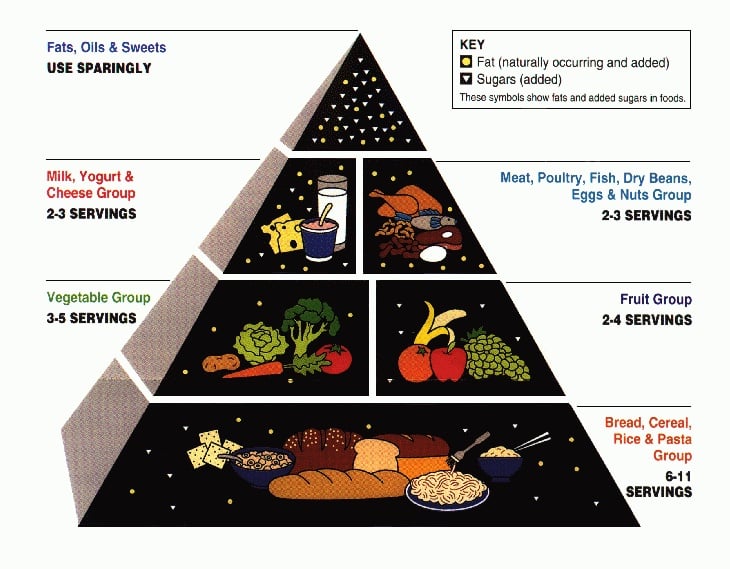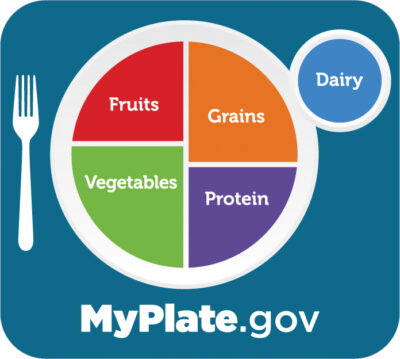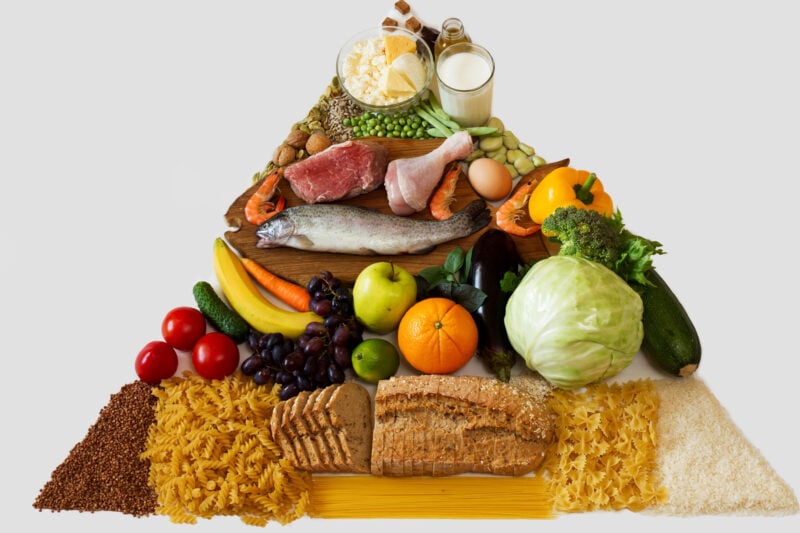In the 1990s, the Food Pyramid was everywhere. The food guidance system, which was developed by the U.S. Department of Agriculture (USDA) as a nutrition education tool for Americans, was plastered on cereal boxes and bagged bread, in TV commercials, and elementary classrooms.
Not only that, it was published at a time when Americans had a dramatically different understanding of what constitutes a healthy diet, fueled by a combination of supply chain imbalances, outdated science, and good marketing. Back then, cholesterol was the enemy, and saturated fat was taboo. Egg whites were encouraged over egg yolks, margarine over butter, and fat-free over full-fat. But low fat invariably meant high carbohydrate—especially wheat—and America had lots of that.
The USDA Food Pyramid finally launched to the public in 1992 (after a year-long delay that many people suspected was to accommodate changes reportedly requested by meat and dairy lobbyists), and it had some peculiar advice. Bread and pasta became the base of the Food Pyramid, and all kinds of fat were at the top. This included olive oil and avocados. That advice would be questioned by both experts at that time and medical professionals who now say it contributed to the nation’s growing obesity crisis.
“The Food Pyramid came under immediate fire, even from those within government,” Robert Lustig, MD, MSL, a Levels Health advisor, writes in his 2021 book Metabolical. In response to the growing obesity crisis, the USDA was forced to back away from the Food Pyramid and in 2011 introduced MyPlate.
What was the USDA Food Pyramid?
The original Food Guide Pyramid (also referred to as the “Eating Right Pyramid”) is a triangle-shaped guide that organizes food into six major food groups. It was intended to be a visual representation of the most recent Dietary Guidelines for Americans in 1990.

The original Food Pyramid from 1992
The idea itself is pretty simple. Eat more of the foods listed at the widest part of the Pyramid and fewer of the foods at the top. The guidance was for Americans to eat 6–11 servings per day of starchy items like bread, pasta, cereal, potatoes, whole grains, and rice at the “base,” depending on the individual. Three to five servings of vegetables and two to four servings of fruit sit above carbs. Then comes two to three servings of milk, cheese, and dairy products, and two to three servings of meat, nuts, and beans. And finally, fats, oils, and sweets are listed at the top of the Pyramid, to be used “sparingly.” This includes everything from cooking oil to soda.
U.S. health officials reportedly picked the Pyramid over a bowl design because it did a better job communicating moderation and proportions. It also mimicked a popular food Pyramid created in Sweden in the 1970s that recommended healthy foods with a focus on affordability and avoiding fat.
The USDA Food Pyramid was controversial from the beginning. After work went into developing the Pyramid for several years, the brochure for the Pyramid was sent to the printer in early 1991. But then representatives for the National Cattlemen’s Association reportedly saw media coverage that “stigmatized their products”—by putting beef in the same category as fats and dairy. The organization joined other industry groups, such as the National Milk Producers Federation, protesting the Pyramid, and the rollout was postponed, according to research published by Marion Nestle, a nutrition and food studies professor at New York University, in the International Journal of Social Determinants of Health and Health Services in 1993.
The Pyramid reportedly spent another year in revisions—at a cost of about $900,000 to taxpayers—and when the updated version was released to the public in 1992, the nutrition experts who developed the guide were surprised by several of the changes. The suggested servings of grains were higher than their original recommendation, and the recommended number of servings of fruits and vegetables had shrunk.
These food-choice changes put the USDA’s own nutritionists at odds with the influential food industry.
“The U.S. Department of Agriculture has an inherent conflict of interest: its primary mission is to ensure the success of the American agriculture industry, so its nutritional advice is an inevitable compromise of vested interests,” said an editorial in the medical journal The Lancet in 2005. “This conflict means the Pyramid cannot communicate what American consumers really need to hear.”
What was wrong with the Food Guide Pyramid?
To understand the Pyramid’s flaws, you have to think about what Americans were eating in those days. Back in the early ’90s, about 15% of the typical American diet came from protein with the rest split between fat and carbs, according to Meir Stampfer and Walter Willett, both of whom are MDs and professors at the Harvard T.H. Chan School of Public Health.
In the 1970’s, very high-protein formula diets resulted in kidney failure, so nutritionists did not want to recommend that Americans eat more protein. Furthermore, sources like red meat are high in saturated fat. The American Heart Association at that time recommended no more than 30% of calories come from fat, in order to help prevent heart disease. What resulted was a simplified message to limit fat intake that didn’t quite stack up with the science.
“The ‘fat is bad’ mantra led to the reciprocal corollary ‘carbs are good,’” Stampfer and Willett wrote in Scientific American in 2006. “Even when the Pyramid was being developed, though, nutritionists had long known that some types of fat are essential to health and can reduce the risk of cardiovascular disease. Furthermore, scientists had found little evidence that a high intake of carbohydrates is beneficial.”
But that wasn’t the only issue with the Pyramid. Critics had a laundry list of concerns:
- Why were foods categorized the way they were? (Nuts, beans, and red meat were lumped in the protein category, while all fats and sweets were considered the same. Sugar was also considered a carbohydrate, whether it came from fruit or from soda.)
- Why did the Pyramid recommend all Americans eat at least six servings of grains a day?
- Why didn’t the USDA differentiate between the types of fats? (By the early 90s, researchers knew that monounsaturated and polyunsaturated fat — both unsaturated — contributed to a healthy diet, while trans-fats were really bad.)
These questions and others eventually led to a revision, called MyPyramid, in 2005, and then the creation of a completely new format, called MyPlate, in 2011.
What came after the USDA Food Pyramid?
MyPyramid riffed off the original Pyramid while also putting in place a handful of changes. The new design didn’t include any details; instead, it assigned a color to each food category—green for vegetables, orange for grains—and promoted MyPyramid.gov, a website that had dietary recommendations while also suggesting people manage total calories and get physical exercise. It was the first federal food guide to have an interactive online component.

The new MyPlate guide
The changes were applauded by some, but by then, there were already concerns that the original Pyramid didn’t do enough to encourage Americans to limit their consumption of refined carbs, and was a driving factor in the growing obesity crisis.
“The goal [of the Pyramid] was to reduce the intake of saturated fat, which raised cholesterol levels,” John Kinney, MD, wrote in an opinion piece in the Current Opinion in Clinical Nutrition and Metabolic Care journal in 2005. “Subsequent data demonstrated that refined carbohydrates such as refined bread and rice caused damage to glucose regulation and insulin levels.”
A study in The Journal of Nutrition in 2006 that analyzed dietary habits for about 4,300 adults found that people who followed the MyPyramid recommendations were more likely to get their nutritional needs met than those who adhered to the original Pyramid. However, the researchers also said that following the newer recommendations could still lead to excessive energy intake, a contributing factor to obesity, chronic diseases, and metabolic disorders.
That said, other researchers have said the Pyramid isn’t to blame for obesity rates. Research published by investigators at Tufts University in 2004 argued that many Americans don’t adhere to dietary guidelines that make up the Pyramid. “The more likely causes of escalating obesity rates are increased per capita caloric consumption and larger portion sizes, along with a lack of adequate physical activity,” the Tufts researchers wrote.
The most sweeping change to America’s food-guide history came in 2011 with the introduction of MyPlate, a totally new design that focuses on a plate with four food groups: vegetables, fruits, protein, and grains. Dairy is represented by a circle placed on the side of the plate, much like a glass of milk. It also recommends physical activity and eating fewer foods with added sugars, saturated fat, and sodium.
The easy-to-understand plate design was applauded by both scientists and the food industry, though there are still concerns about some of the recommendations and their purported health benefits, and some researchers have come up with their own food guides.
Tufts researchers in 2021 created the Food Compass, which scores food on its healthfulness as a part of a nutrient-profiling system.
More than a decade earlier, Harvard University’s School of Public Health launched the Healthy Eating Pyramid, which put daily exercise and maintaining a healthy weight as the foundation of the Pyramid (compared with eating grains, like the original Food Guide Pyramid). It also recommended focusing on the type of food instead of the serving size, eating plants, cutting back on “American staples” like red meat and sugary drinks, and taking a multivitamin or drinking a glass of wine.
“MyPlate mixes science with the influence of powerful agricultural interests, which is not the recipe for healthy eating,” Harvard’s Willett said in 2011.
That said, the MyPlate is still the nation’s nutrition guide.
“To its credit, at least MyPlate didn’t tout refined carbohydrates; however, its low-fat imperative continues to miss the point and it somehow still categorizes fruit juice and fruit and veggie straws as a vegetable,” Lustig wrote in Metabolical. “The evidence base for any and all of these classification systems is spotty at least and nonexistent at worst.”
 Want to learn more about Levels and CGM?
Want to learn more about Levels and CGM?
Levels, the health tech company behind this blog, helps people improve their metabolic health by showing how food and lifestyle impact your blood sugar, using continuous glucose monitoring (CGM), along with an app that offers personalized guidance and helps you build healthy habits. Click here to learn more about Levels.

 Want to learn more about Levels and CGM?
Want to learn more about Levels and CGM?






